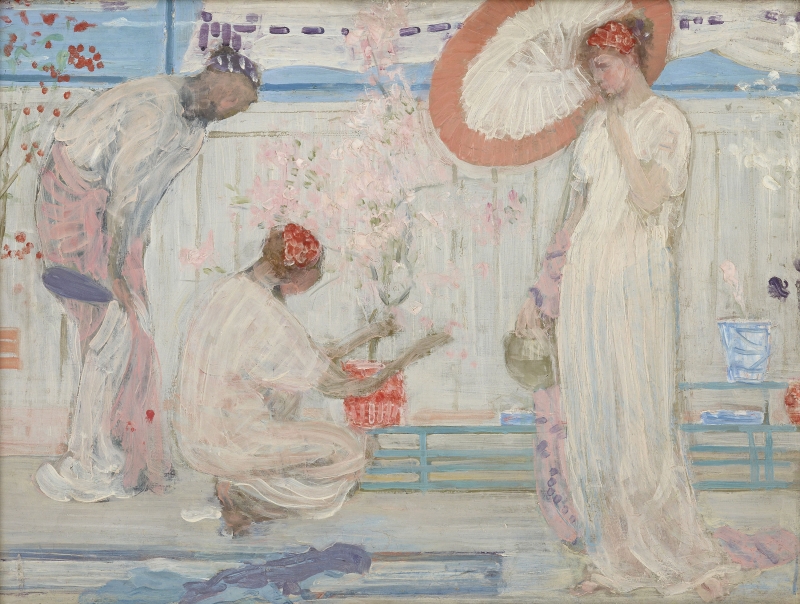Titles
Possible titles include:
- 'Symphony in White and Red' under the heading 'Sketches for Large Paintings' (1874, Flemish Gallery). 1
- 'Symphony in White and Red' (1887, Royal Society of British Artists,). 2
- 'The White Symphony' (1903, C. L. Freer). 3
- 'The White Symphony' (1904, Copley Society, Boston). 4
- 'The White Symphony: Three Girls' (1980, YMSM). 5
During Whistler's lifetime, this was twice exhibited with the title 'Symphony in White and Red'. A painting in Whistler's studio at his death has the same title, Symphony in White and Red [YMSM 085].
To avoid confusion, the preferred title is 'The White Symphony: Three Girls'.
Description
A figure composition in horizontal format. Three women in white robes admire flowers in a formal garden-like setting. The woman at left has a pink stole, and stands bending forward to right with her hands on her knees. The woman in the centre is crouching, facing back and to right, with her arms reaching out to a plant in a bright reddish-orange pot that sits on a low table or dais. At far right there are pale blue and white pots, one with a pink flower. The woman at right, facing left, wears a red headband or scarf, and holds a round jug in her right hand; her left arm crosses her body, holding over her right shoulder a large white parasol with red edging. Behind the figures is a white shoulder-high fence. A blue open framework and a white awning with purple dotted edge are visible above the fence, against a blue sky. The floor is white with possibly a blue striped rug at left, and pale blue and lilac material has been dropped in the foreground. At upper left is a tree with bright red blossoms or berries, and at upper right, white blossom above a purple flower in a red pot (this being cut off by the edge of the canvas).
A contemporary description was full and unflattering:
'This is a composition of three figures, whose faces are simply daubs, and whose bodies bend in and out in a most snake-like fashion. At least this is the attitude taken by the male with a purple fan in his hand and the lady standing opposite, while the third figure, a male "gent," is squatted on the ground like a Japanese, in the act of trimming a shrub. His hands are lost in a cloud of paint, and his right arm from the elbow is apparently twice as long as his shoulder is from the elbow. They are draped in what might be called esthetic winding-sheets, and taken all in all are decidedly very grave-looking objects. We see spots of red on one portion of the work, pink dashes elsewhere, and a lot of white everywhere; and this is the harmonious symphony we are called upon to admire! No one, I should think, but Mr. Whistler would have the audacity to place such a composition before the British public under the name of a painting, but I see he calls it a symphony, and as such it must pass for another of his discordant "notes." ' 6
Sitter
There were probably several models over the years. At a late stage in the evolution of the figure at left, Matilda Gilchrist (b. 1828 or 1829) posed for the drypoint Tillie: A Model [113], and several drawings, including Tillie: Study in Pink and Mauve [M.0370], in the same pose as the standing figure at left (the figure appears in reverse as printed) .
Comments
Robin Spencer commented that 'The arrangement of the 'Three Girls' parallels Albert Moore's Pomegranates (Guildhall Art Gallery, London) of 1866, and also the figures in certain Japanese prints.' 7 Pomegranates is an interior scene, with three women in robes of pink, lilac and warm red shades bend, crouch and lean over a pink and white cabinet. The dresses and the surroundings – a wall hanging in white and pale blue, a woven patterned rug, a bowl of fruit and a black two-handled vase, and a spray of leaves as well as a general air of doing almost nothing on a warm day – have strong links with Whistler's aesthetic semi-classical subjects.
Notes:
1: Mr Whistler's Exhibition, Flemish Gallery, 48 Pall Mall, London, 1874 (cat. no. 13).
2: Winter Exhibition, Royal Society of British Artists, 1887-1887 (cat. no. 352).
3: Freer, quoting Whistler, in letter to R. Birnie Philip, 30 November 1903, Freer Gallery Archives.
4: Oil Paintings, Water Colors, Pastels and Drawings: Memorial Exhibition of the Works of Mr. J. McNeill Whistler, Copley Society, Boston, 1904 (cat. no. 19).
5: YMSM 1980 [more] (cat. no. 87).
6: 'The London Art Galleries', Eastbourne Review, 9 December 1887; press cutting in GUL Whistler PC9, p. 42.
Last updated: 23rd November 2020 by Margaret







